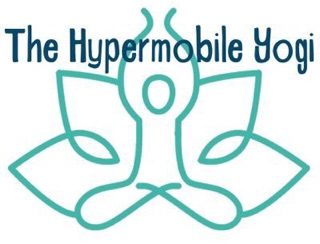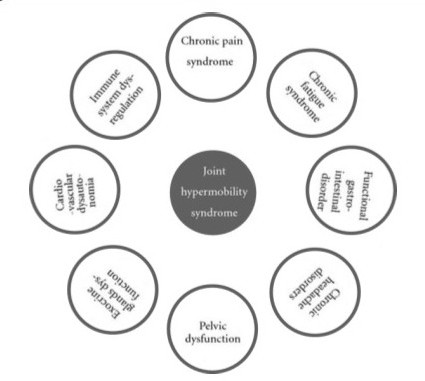‘For these people, hypermobility may even be considered an advantage, for example, athletes, gymnasts, dancers and musicians might specifically be selected because of their extra range of movement. For a small percentage of the population, however, instead of being advantageous, hypermobility may be associated with joint and ligament injuries, pain, fatigue and other symptoms’ (Hakim A – www.hypermobility.org).
The exact cause(s) of joint hypermobility is unknown; however, “loose joints” are believed to be caused by various mutations to one or more of the components that help build our connective tissues. Research is suggesting that both genetic and epigenetic factors play a role in the presentation signs and symptoms, as well as the severity of issues associated with joint hypermobility. In some individuals, joint hypermobility is an indication of a type of hypermobility syndrome, such as Ehlers-Danlos syndrome – hypermobility type (EDS-HT). Hypermobility syndromes are classified as heritable connective tissue disorders or connective tissue diseases. There are several types of hypermobility syndromes. Ehlers-Danlos syndrome (EDS) is a type of hypermobility syndrome and Ehlers-Danlos syndrome – Hypermobility Type, is a type of EDS. EDS is a group of heritable connective tissue disorders caused by mutations in either the structure or function of collagen – the most abundant protein in the body. While research is still searching to understand the complexities of EDS, it is certain that most forms of EDS can cause a broad spectrum of multisystemic dysfunction. Additionally, some EDS researchers speculate that Ehlers-Danlos syndrome – Hypermobility Type may be the most prevalent connective tissue disorder in the world.
‘Experts estimate that up to 10% of the general population may have some degree of hypermobility, with women affected about three times more often than men. Most hypermobile people do not develop any problems from their loose joints, but some suffer chronic pain and other symptoms. Those who do experience chronic joint pain and other symptoms related to their hypermobility or to the looseness of other tissues that often accompanies hypermobility have a condition called joint hypermobility syndrome (JHS).’ (Pocinki A – http://www.dynakids.org/Documents/hypermobility.pdf)
Presently, it’s widely accepted that Benign Joint Hypermobility Syndrome (BJHS), Joint Hypermobility Syndrome (JHS), and Hypermobility Syndrome (HMS) are one in the same condition. Some EDS and hypermobility researchers believe that BJHS/JHS/HMS and EDS-HT are one in the same condition entirely. Others believe that the two conditions are “allelic,” meaning “different mutations at the same locus cause a similar phenotype” (https://en.wikipedia.org/wiki/Allelic_heterogeneity) and are clinically indistinguishable. An easier explanation may be that it doesn’t matter how a gene is interrupted (mutated), but that it can be interrupted (mutated) a few ways. These different gene interruptions (mutations) may cause a similar presentation of symptoms.
It is thought that many people who were first diagnosed with (BJHS), (JHS), (HMS), or “just loose joints,” later receive diagnosed with a type of Ehlers-Danlos syndrome – Hypermobility Type (EDS-HT). However, some are re-diagnosed with a different kind of hypermobility syndrome, for example, another form of EDS, Marfan syndrome or connective tissue diseases such as Lupus, Rheumatoid Arthritis, or even Fibromyalgia. The first sign or symptom of EDS-HT is usually joint hypermobility, and many people do not experience issues with their loose joints until later in life, for example during puberty, if at all. On the other hand, some individuals with EDS-HT have multisystemic problems from birth.
People with hypermobility syndromes, including EDS-HT, have symptoms ranging from an incredibly broad scale of severity, in addition to hypermobile joints such as the knees, shoulders, neck, ankles, fingers, wrists, the pelvis, the jaw, and more. Because components of connective tissue can be found everywhere in our bodies, not only supporting our joints, it is possible that every system in the body can be affected. Confusion and misdiagnosis have only increased because not one person with hypermobility presents the same – EDS-HT is especially subjective. Awareness, education, and early intervention are critical. Over-medicalization, or lack of proactive approaches to living well with joint hypermobility, can cause damage to the connective tissues, progress multi-systemic dysfunction, and cause life-long and additional trauma, pain and suffering.
A perfect example is described on the website for the EDS 2016 International Symposium (eds2016.org) – ‘If one builds a house with inadequate materials, perhaps half [of] the necessary wood or aluminum nails, one knows there will be problems. Some problems can be anticipated, but because those materials were used everywhere and aren’t necessarily visible, one may be surprised. Being built out of a protein that doesn’t behave the way it should result in widespread difficulties in a wide range of severities, even in places one wouldn’t think are connected until one realizes that collagen is used there, too.’
While there is still so much more discover and understand about joint hypermobility and Hypermobility syndromes, such as Ehlers-Danlos syndrome – Hypermobility Type (EDS-HT), what is recognized by those within the broader hypermobility community, but has yet to be fully acknowledged and accepted by the entire medical field, is that EDS-HT is a multisystemic condition(s) that is much more than “just the joints.”
Symptoms / Comorbidities of Joint Hypermobility syndrome/Ehlers-Danlos syndrome – Hypermobility Type often includes, but are not limited to:
– joint hypermobility (not to be confused with flexibility, as people can be hypermobile without being flexible and vice versa—hypermobile joints are loose or unstable and slip or dislocate easily)
– complete dislocations and partial dislocations (known as subluxations)
– prone to bruising easily and some may have tissue fragility
– vascular complications, such as pelvic congestion syndrome
– bladder problems (i.e. Interstitial Cystitis, etc.)
– poor wound healing
– abnormal scarring
– chronic fatigue
– chronic pain
– cardiac abnormalities
– foot deformities
– TMJ dysfunction
– low muscle tone
– hernias
– early osteoarthritis and degenerative discs
– various GI problems and allergies
– chronic headaches
– eye problems
– Dysautonomia (i.e. POTS)
– dental issues
– chronic pelvic pain in women and various gynecological issues
– congenital defects of the spine (including the head, neck, and the entire spinal column)
– ADD/ADHD
– learning disabilities
– Sensory Processing issues
– Autism
– Neuropathy
– circulatory issues
– and much more.
“The first step necessary to increase awareness regarding JHS/EDS-HT is to shift attention from the overall musculoskeletal /cutaneous picture to the chronology of symptom development, transition, and evolution.”
– M Castori et al. Am J Med Gen 2013
Learn more – ‘What is Hypermobility Syndrome?’
***Published with permission from EDS Wellness. Content is copyright protected.***

